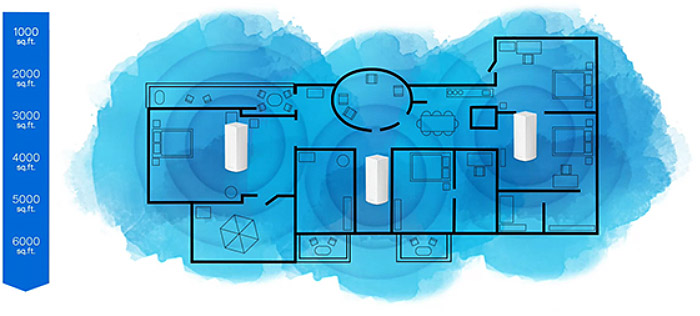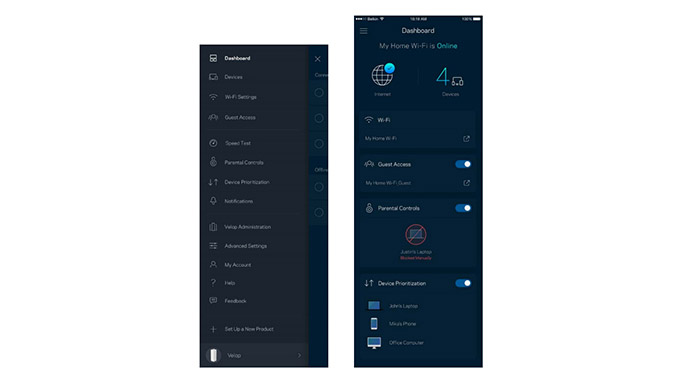It’s interesting to see this mash-up of so many technologies, but I have a feeling that the Linksys Velop is more an experiment for Linksys to see which is the better approach for a proper domestic mesh network.

In order to test the wireless performance, I connected the first Velop router to a cable modem and the next two nodes were added using the Spot Finder Technology to make sure I don’t put too much space between the routers. Considering that after I tested Velop’s wireless performance almost half a year ago, Linksys has released several software updates which seem to have improved quite a bit its performance, so let’s see how does it fare against the older test (the previous results will be kept inside brackets for reference).
First, I used a single unit setup and connected a 3×3 client to the network. In close proximity to the unit (around 5 feet), I measured 525 Mbps (482 Mbps), while at no more than 15 feet, the speed slightly decreased to 471 Mbps (423 Mbps).
After further increasing the distance between the client and the router to 30 feet, I managed to measure 210 Mbps (193 Mbps). Next, I added a second node to the system and again measured the wireless performance using a 3×3 laptop. So, at 5 feet from the second unit, I managed to measure an average of 381 Mbps (354 Mbps), while at around 15 feet, the speed decreased to 321 Mbps (289 Mbps). Lastly, at 30 feet, I measured an average of 205 Mbps (185 Mbps). Furthermore, I added the third node to the system and once again, I measured the wireless performance using the laptop with a compatible wireless adapter. At 5 feet away from the third unit, I measured an average of 338 Mbps (320 Mbps) and at 15 feet, the speed slightly decreased to an average of 300 Mbps (288 Mbps). After increasing the distance to 30 feet, I managed to measure an average of 219 Mbps (216 Mbps).
I maintained the three nodes setup and, this time, I connected a 2.4GHz typical device to the network. At close range (5 feet), I was able to measure an average of 136 Mbps (112 Mbps) and the speed gradually decreased to 120 Mbps (104 Mbps) at 15 feet and at 81 Mbps (53 Mbps) at 30 feet. The Linksys Velop supports the MU-MIMO technology, so it would be a shame not to see how does it perform if one would have 3×3 compatible wireless adapters. So, I managed to get a hold on three computers with a MU-MIMO wireless adapter and, using the three-node Velop system I got the following results: at 5 feet, I measured around 80 Mbps (72 Mbps), at 15 feet, the speed decreased to 69 Mbps (66 Mbps), while at 30 feet, I measured no more than 62 Mbps (57 Mbps). The two node setup did not give much improvement (I gained about 10 to 12 Mbps in each location), but using a single Linksys Velop unit greatly improved the wireless performance: near the router, I measured around 240 Mbps (228 Mbps) and, as I gradually increased the distance to 15 and later, to 30 feet, the speed decreased to 168 Mbps (156 Mbps) and, respectively to 121 Mbps (99 Mbps).
The truth is, as with the WRT3200ACM, Linksys may confuse some people using the inflated number on the box (AC6600). Each unit is advertised as an AC2200 class router, which adds the maximum wireless capability of the second 5GHz, thus making each unit, in reality an AC1200 class router (or AC1300, if you round it from the 1267 Mbps) that can handle more 5GHz compatible clients.
It’s worth noting that the Linksys Velop has taken into account the possibility of working as a smart hub for smart home devices since it has a Zigbee radio within, but it seems that it is inactive, for now. Furthermore, Linksys also is interested into Amazon’s Alexa service and has added some cool voice-activated commands for turning On or Off the Guest WiFi, as well as requesting the Guest password and the WiFi password of the main network.
Note: It’s worth mentioning the fact that each node has the ability of covering 2,000 square feet of WiFi.
Setup and Interface
The setup process can only be done using the Linksys app available only for mobile phones (compatible with iOS 8.x version or newer and Android 4.0.3 or newer). It seems that more and more manufacturers sacrifice some good features for the sake of unwanted simplicity and Linksys is guilty of this, since it decided to ignore the Desktop PC platform and force people to only use tablet or phone-based devices to perform the setup. Of course, some people found that there actually is a ‘hidden’ web-based interface which Linksys say it’s only for its staff in case the system needs servicing.
So, to perform the initial setup, you have to download the app to your tablet/smartphone and follow the on-screen instructions: first, you’ll be asked if the Internet comes from a Modem and Router or from a Modem-Router device, you’ll be notified to prepare the necessary equipment, verify the top LED colour (should be blinking purple), you’ll be asked to connect the node to the modem (the connection data will automatically be gathered) and if the connection has been successful, you’ll be asked to personalize your WiFi (name and password), choose the node location (living room, kitchen and so on) and if you want to add another node to create a mesh network (the Spot Finder feature will automatically detect the best spot for your next nodes). And that’s pretty much the setup process. It is very user-friendly and easy to follow, but in truth, the entire process is really slow and may take up to 20 minutes to complete it.
The app dashboard shows the status of the Velop system and the Internet connection, as well as the number of connected devices (click to reveal a list of all connected devices and a list of all offline devices – click on any device to see some info and turn on the Parental Controls and the Device Prioritization), the WiFi networks, the Guest Access, the Parental Controls and the Device Prioritization.
Of course, there’s also a main menu (vertically aligned) with the following options: Dashboard, Devices, WiFi Settings (here, you can change the name and password, connect a device using WPS or access the Advanced Settings: change the Security Type and the WiFi mode or run the Channel Finder to discover the best channel for each node), Guest Access (create a WiFi name and password for a separate network which will be used by your guests), Speed Test, Parental Controls (here, you can manage the online time and configure the website access, as well as Add Devices under the new rules), Device Prioritization (allows you to add three devices for the highest priority, while other devices will share the leftover capacity), Notifications (e.g. get notifications whenever a node is offline), Velop Administration (change the router password and hint, turn on the Automatic Firmware Update, check the IP details and Restart the router), Advanced Settings (Internet Settings, Port Settings and WiFi MAC Filters), My Account, Help, Feedback and Set Up a New Product.
If you’re not satisfied by the Linksys app and want to have access to more options to perform a more in-depth configuration, then you can use the back-end hidden admin interface, which can be accessed (at the time of writing – they may patch this option out) by going to LOCAL_IP/ui/dynamic/advanced-wireless.html. The reason why Linksys doesn’t want you to use this interface is because there is a risk of destabilizing the whole system, so tread carefully.
Conclusion
The Linksys Velop definitely raises the bar for how a mesh network should perform, being suitable for a large house + surrounding property (the three units setup is overkill for smaller homes), it provides a stable and seamless wireless connection to a larger number of devices and overall, does a lot of things right. Of course, there are some shortcomings, such as a limiting interface and a high price, but I expect that these inconveniences will be fixed in the upcoming months, making the Linksys Velop one of the most attractive mesh solutions on the market.
Check the product here:

Mark is a graduate in Computer Science, having gathered valuable experience over the years working in IT as a programmer. Mark is also the main tech writer for MBReviews.com, covering not only his passion, the networking devices, but also other cool electronic gadgets that you may find useful for your every day life.






